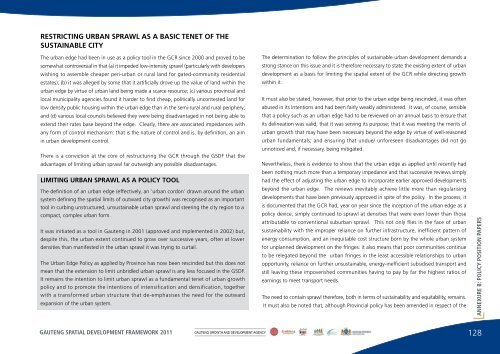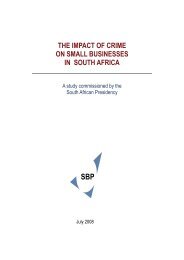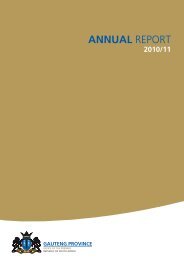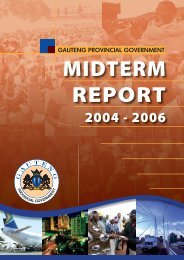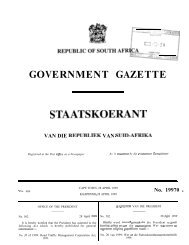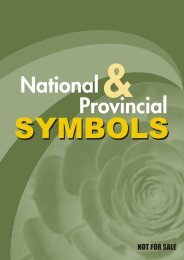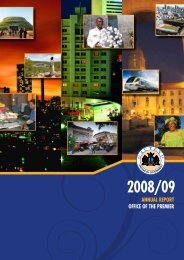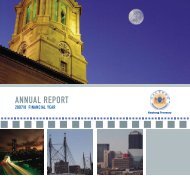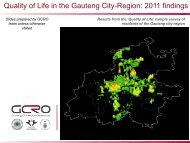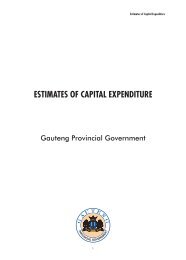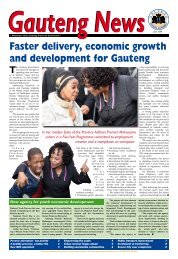the gauteng spatial development framework - Gauteng Online
the gauteng spatial development framework - Gauteng Online
the gauteng spatial development framework - Gauteng Online
Create successful ePaper yourself
Turn your PDF publications into a flip-book with our unique Google optimized e-Paper software.
RESTRICTING URBAN SPRAWL AS A BASIC TENET OF THESUSTAINABLE CITYThe urban edge had been in use as a policy tool in <strong>the</strong> GCR since 2000 and proved to besomewhat controversial in that (a) it impeded low-intensity sprawl (particularly with developerswishing to assemble cheaper peri-urban or rural land for gated-community residentialestates); (b) it was alleged by some that it artificially drove up <strong>the</strong> value of land within <strong>the</strong>urban edge by virtue of urban land being made a scarce resource; (c) various provincial andlocal municipality agencies found it harder to find cheap, politically uncontested land forlow density public housing within <strong>the</strong> urban edge than in <strong>the</strong> semi-rural and rural periphery;and (d) various local councils believed <strong>the</strong>y were being disadvantaged in not being able toextend <strong>the</strong>ir rates base beyond <strong>the</strong> edge. Clearly, <strong>the</strong>re are associated impedances withany form of control mechanism: that is <strong>the</strong> nature of control and is, by definition, an aimin urban <strong>development</strong> control.There is a conviction at <strong>the</strong> core of restructuring <strong>the</strong> GCR through <strong>the</strong> GSDF that <strong>the</strong>advantages of limiting urban sprawl far outweigh any possible disadvantages.LIMITING URBAN SPRAWL AS A POLICY TOOLThe definition of an urban edge (effectively, an 'urban cordon' drawn around <strong>the</strong> urbansystem defining <strong>the</strong> <strong>spatial</strong> limits of outward city growth) was recognised as an importanttool in curbing unstructured, unsustainable urban sprawl and steering <strong>the</strong> city region to acompact, complex urban form.It was initiated as a tool in <strong>Gauteng</strong> in 2001 (approved and implemented in 2002) but,despite this, <strong>the</strong> urban extent continued to grow over successive years, often at lowerdensities than manifested in <strong>the</strong> urban sprawl it was trying to curtail.The Urban Edge Policy as applied by Province has now been rescinded but this does notmean that <strong>the</strong> extension to limit unbridled urban sprawl is any less focused in <strong>the</strong> GSDF.It remains <strong>the</strong> intention to limit urban sprawl as a fundamental tenet of urban growthpolicy and to promote <strong>the</strong> intentions of intensification and densification, toge<strong>the</strong>rwith a transformed urban structure that de-emphasises <strong>the</strong> need for <strong>the</strong> outwardexpansion of <strong>the</strong> urban system.The determination to follow <strong>the</strong> principles of sustainable urban <strong>development</strong> demands astrong stance on this issue and it is <strong>the</strong>refore necessary to state <strong>the</strong> existing extent of urban<strong>development</strong> as a basis for limiting <strong>the</strong> <strong>spatial</strong> extent of <strong>the</strong> GCR while directing growthwithin it.It must also be stated, however, that prior to <strong>the</strong> urban edge being rescinded, it was oftenabused in its intentions and had been fairly weakly administered. It was, of course, sensiblethat a policy such as an urban edge had to be reviewed on an annual basis to ensure thatits delineation was valid; that it was serving its purpose; that it was meeting <strong>the</strong> merits ofurban growth that may have been necessary beyond <strong>the</strong> edge by virtue of well-reasonedurban fundamentals; and ensuring that undue/ unforeseen disadvantages did not gounnoticed and, if necessary, being mitigated.Never<strong>the</strong>less, <strong>the</strong>re is evidence to show that <strong>the</strong> urban edge as applied until recently hadbeen nothing much more than a temporary impedance and that successive reviews simplyhad <strong>the</strong> effect of adjusting <strong>the</strong> urban edge to incorporate earlier approved <strong>development</strong>sbeyond <strong>the</strong> urban edge. The reviews inevitably achieve little more than regularising<strong>development</strong>s that have been previously approved in spite of <strong>the</strong> policy. In <strong>the</strong> process, itis documented that <strong>the</strong> GCR had, year on year since <strong>the</strong> inception of <strong>the</strong> urban edge as apolicy device, simply continued to sprawl at densities that were even lower than thoseattributable to conventional suburban sprawl. This not only flies in <strong>the</strong> face of urbansustainability with <strong>the</strong> improper reliance on fur<strong>the</strong>r infrastructure, inefficient pattern ofenergy consumption, and an inequitable cost structure born by <strong>the</strong> whole urban systemfor unplanned <strong>development</strong> on <strong>the</strong> fringes: it also means that poor communities continueto be relegated beyond <strong>the</strong> urban fringes in <strong>the</strong> least accessible relationships to urbanopportunity, reliance on fur<strong>the</strong>r unsustainable, energy-inefficient subsidised transport andstill leaving <strong>the</strong>se impoverished communities having to pay by far <strong>the</strong> highest ratios ofearnings to meet transport needs.The need to contain sprawl <strong>the</strong>refore, both in terms of sustainability and equitability, remains.It must also be noted that, although Provincial policy has been amended in respect of <strong>the</strong>ANNEXURE B: POLICY POSITION PAPERSGAUTENG SPATIAL DEVELOPMENT FRAMEWORK 2011GAUTENG GROWTH AND DEVELOPMENT AGENCY128


